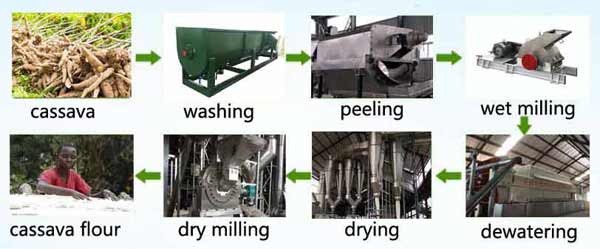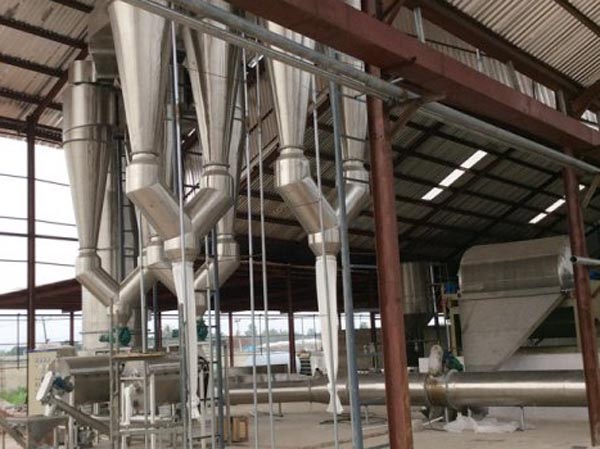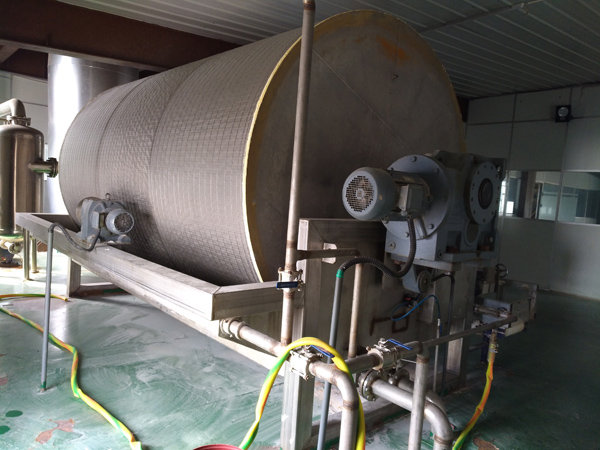cassava flour production plant in Nigeria

Cassava flour processing machine
The cassava plant produces huge ornamental leaves. They can thrive in summer in most parts of the United States. The increase in temperature promotes the fastest growth. There are several chewing pests that can cause leaf damage, but other than that, cassava is relatively disease-free. Good cassava plant care should include the use of slow-release fertilizers in the spring. Keep plants moderately moist. In order to protect the plants,
Move it indoors before the temperature. In winter, cassava is in a warm, well-lit place and transplanted outside when the soil warms up.
There are two ways to process cassava flour, traditional dry flour milling and advanced wet flour milling. It is produced by the traditional dry processing method, that is, the peeled cassava is cut into thin slices, then dried and crushed into flour. But it has the disadvantages of low quality and high power consumption. In order to solve this problem, the cassava flour processing machine adopts the latest processing technology, called wet processing. We tune
In the sequence of grinding and drying, the cassava chunks are crushed first, and then dried. Compared with the dry method, the wet method can save energy in the drying process and make instant drying a reality, thus ensuring the continuous and automatic production of the entire cassava flour production line. In addition, our cassava flour processing machine can produce higher quality cassava flour finished products.
For the wet-processed cassava flour production line, the following processing sequence is adopted:
Cassava tuber cleaning-washing and crushing-crushing-dehydration-sieving-packaging.
According to the technology, the main components of the cassava flour processing machine are dry screen, paddle washing machine, cutting machine, knife grinder, desander, filter press, rapid dryer, vibrating screen and automatic packaging machine. We ensure that all parts that may come into contact with the cassava material are made of stainless steel to meet hygiene requirements and improve the quality of the finished flour.
The following is the brief introduction of the tapioca flour processing machine in different parts of the tapioca flour production line:
1. Clean the part
The cleaning part is also called raw material pretreatment. In this process, the cassava tubers are cleaned up, and then the next step is broken. The cassava flour processing machine used in this section is a dry sieve and a paddle washing machine.
First, the cassava tubers are passed through a drying sieve machine to remove impurities attached to the surface of the tubers, such as sand, weeds, metals, debris, and stones. Through the rotation of the drying sieve, the internal spiral of the equipment moves the cassava tuber forward, and at the same time the impurities will be removed and fall from the gap between the steel bars.
Then transfer the washed cassava to a paddle washing machine for thorough washing. The countercurrent washing principle is adopted, that is, the forward direction of cassava is opposite to the direction of water flow to achieve better cleaning effect. , No water is added at the beginning of the second washing tank, which increases the friction between the cassava tubers and therefore improves the peeling rate.
2. Processing Department
After the cleaning part is over, enter the processing part. A cassava flour processing machine such as a crusher is used in this process with a grinder, a sharpener and a de-sander.
First, the shredder cuts the washed tubers into small pieces, thereby reducing the workload of the subsequent shredder and increasing the output. Use a wooden file to crush the cassava into fine cassava powder. However, the maintenance rate of the machine is high, and other hammer mills have a long service life and low maintenance rate. Therefore, wood flour is one of the cassava flour processing equipment, which will affect the quality of the finished flour. After crushing, a certain amount
The water is added to the cassava flour slurry so that it can be pumped into the desander to remove the sand.
3. Drying section
After cleaning section and processing section, we will get cassava pulp. Then the tapioca flour processor filter press and flash dryer are applied to the dehydration and drying process.
First, pump the cassava slurry into the filter press for dewatering. The filter press is equipped with filter cloth. Under the action of pressure and squeezing, the material is squeezed and separated, and then dropped into the cassava flour collection box. After dehydration, the moisture content of the flour is about 30%-40%.
The cassava flour dryer is a rapid dryer. It can dry cassava flour in a short time. The position of the fan determines that the drying system will operate under negative pressure, thereby reducing the loss of flour in the exhaust pipe. In order to reduce the moisture content of the flour, a two-stage drying system can be installed.
4. Screening and packaging part
After drying, we get dried finished tapioca flour. But in order to ensure the high quality of cassava flour, a vibrating sieve machine is used to separate coarse flour of larger size and lower quality. In addition, the grinder can re-pulverize and siev the coarse flour to reduce flour loss and increase yield.
Finally, an automatic packaging machine is installed to weigh and pack the bags. The scales weigh 1-5kg and 5-50kg. This cassava flour processing machine can greatly improve work efficiency and ensure the weight tolerance accuracy of packaging.
In addition to the cassava flour processing machine, control systems such as LCB, MCC, OCC and PLC will be installed to make the entire factory highly automated, easily control all cassava flour processing machines, and make the entire production line run smoothly and continuously. The automatic control system is optional and can be adjusted according to the actual situation and project budget. If you are interested in cassava flour processing machine, welcome to consult.
Cassava requires at least 8 months of frost-free weather to take root. It is easy to grow and harvest cassava roots. The roots can be harvested, cooked, and eaten as soon as they are formed, but if you are looking for some bumper products, you may want to take a while. Some early cassava varieties can be harvested 6-7 months after planting. However, most varieties of cassava usually have a plump harvestable size around 8-9 months.
How much does a cassava starch Read More
How much does a cassava starch machine cost - The price of a cassava starch production line machine...
The cassava starch production lRead More
The following are the main steps and equipment components of a typical cassava starch production line:Cleaning and peeling: Clean the harvest...

scale cassava flour processing
This is the second time that a Nigerian customer has purchased cassava processing equipment from SDA Holdings-Kaifeng SDA Agricultural Equipment Engineering Co., Ltd. Nigerian customers have previously purchased a cassava peeling machine. SD
Read More
Cassava starch production plant
Cassava starch production plant installed in Nigeria,One day processing 100 tons of tapioca starch processing machinery and equipment,We provide customers with tapioca starch processing machine turnkey engineering
Read More



 machine366@outlook.com
machine366@outlook.com




